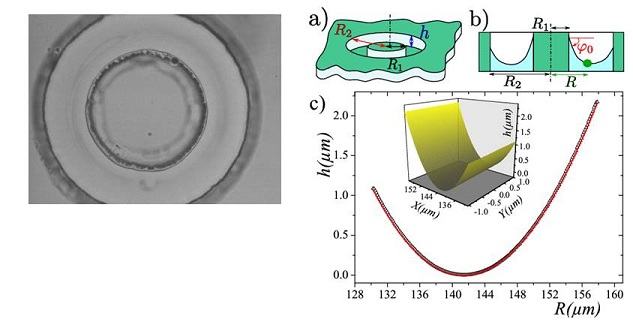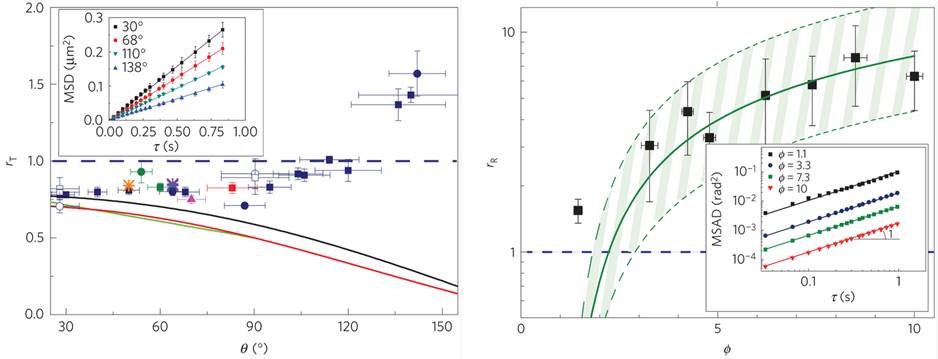Rechercher
Accueil > La Recherche > Axes & Equipes > Matière Molle & Verres > Equipe : Matière Molle > Thème : Interfaces complexes
Dynamics of passive colloids at the interfaces of simple fluids
publié le , mis à jour le
Dynamics of passive colloids at the interfaces of simple fluids
People involved : Blanc C., Nobili M., Stocco A., Gross M., In M., Chollet B.
The interface between two fluids is extremely efficient to trap particles ranging from nanometer to millimeter sizes. In the past, this strong 2D confinement has been used to address fundamental problems of condensed matter physics considering colloids as “big” atoms. Nowadays the interest for these systems is enriched by their large impact for applications and industrial processing. In particular making functional materials by externally driven colloidal assembly at the interface needs the control and tuning of particles dynamics (1) and the forces acting on them (2). In addition to enrich the properties of the obtained materials an extension of all these studies to more complex colloidal morphologies beyond the spherical one is suited.
1. Brownian diffusion of a partially wetted colloid : triple line effects on the particle viscous drag
Each of us has experienced that air bubbles in the champagne go back faster to the surface than in the honey. This phenomenon is governed by the well established Stokes law : the resistance of a fluid to the motion of a bubble or a particle is all the greater the greater the viscosity of the fluid. Unlike the viscous movement in the volume very little is known about the dynamics of micrometric objects at the interface between two fluids in spite of the importance that has this phenomenon in the stabilization of the foams, the formation of biofilms, the depollution of the wastewater. This dynamic is controlled by the degree of partition of the particle between the two fluids via its contact angle. Previous researches lacking of an in-situ technique to measure the particle contact angle had studied the dynamics of solid particles at the air-water interface in a small range of contact angles.
We managed to explore a wide range of contact angles. By controlling the hydrophobicity via the degree of functionalization of silica particles ranging from 2 to 8 microns in diameter, we were able to vary the contact angle by 30 ° (particle more in water) to 140 ° (particle more in air). The contact angle was measured using a Mirau-type interferometric topography technique developed in the laboratory. In this technique, the profile of the interface in the presence of the particle is reconstructed thanks to the interference between the beam of light reflected by the interface and that reflected by a reference mirror. This in situ and non-invasive technique makes it possible to follow in parallel the movement of the colloids in the plane of the interface by "particle tracking". The aim here is to measure the Brownian-type thermal diffusive motion of the particle. A series of images (some ten thousand) containing the particle at the interface is taken at regular intervals of 30 frames per second. A procedure for adjusting the envelope of the intensity of light transmitted by the particle makes it possible to return to its position with an accuracy of up to 4 nm. This measurement indicates the viscosity felt by the particle at the interface. Hydrodynamic theories predict that the effective viscosity should be between that of water and that of air which is 50 times lower then water. Our measurements show that the particle "feels" a viscosity at the water-air interface which is 1.5 times greater than that in water for spherical particles and reaches ten times the one of water for ellipsoidal particles.
Fig. 1 : (a) Translational viscosity ratio (interface/volume) r_T of spherical particles at an air/water interface versus the particle’s contact angle. Contrary to any established theory and also to common sense, particles “feel” a greater viscosity when they are more in the air than in the water (great contact angles). (b) Rotational viscous-drag ratio (interface/volume) r_R of ellipsoidal particles at an air/water interface versus aspect ratio PHI. Even if just three quarter of particle is in water, its rotational drag increases by a factor ten at high aspect ratios.
Going back to our initial example it is as if a bubble of air trapped between champagne and honey would go up less quickly than in honey. This unexpected phenomenon was explained by the contribution of the dynamics of the triple line (the line where the three phases water, air, particle meet) to the friction of the particle that had not been considered in any of the existing theories.
Fig. 2 : (a) Scanning electron microscope image of a silica bead with a 90° contact angle at the water/air interface. (b) and (c) illustrations of the fluctuating forces on the particle related to the fluctuations of the triple line (line where the three water/air/particle phases meet).
It is very likely that this slowing down of dynamics due to the combination of the viscous friction of the particle, the solid friction of the triple line and the fluctuations is an universal property of any interfacial system and that it affects the movement of particles in Pickering emulsions, the proteins in a cell membrane and the bacteria in biofilms.
References :
- Boniello G., Blanc C., Fedorenko D., Medfai M., Ben Mbarek N., In M., Gross M., Stocco, A., Nobili M., Brownian diffusion of a partially wetted colloid. Nature Materials E, vol. 14 p.908 (2015).
- Boniello G., Stocco A., Gross M., In M., Blanc C., Nobili M., Translational viscous drags of an ellipsoid straddling an interface between two fluids. Physical Review E, vol. 94 p.012602 (2016).
2. Control & tuning of forces on spherical colloids via interface curvature
When the fluid interface is non-uniformly curved due to boundary conditions on the walls containing the fluids a capillary coupling between the colloids and the local curvatures is expected. Models predict that a force proportional to the gradient of the local Gaussian curvature of the interface acts on the trapped particle. In order to test these theoretical predictions we design by photo-lithography sub-millimetric cuvettes to create air/liquid interfaces with an imposed gradient of Gaussian curvature. Using a null force method where the know gravity force competes with the curvature force, we are able to measure extremely tiny curvature forces down to few femto-Newton. Our experimental results are in good agreement with theoretical predictions.

Fig. 3 : Toric cuvette designed by photolithographic methods. The fluid interface measured in c) has an uniform mean curvature but a greatly non-uniform Gaussian curvature.
Reference :
- Ch. Blanc, D. Fedorenko, M. Gross, M.In, M. Abkarian, M. Gharbi, J.-B. Fournier, P.Galatola, M.Nobili, Capillary force on a micrometric sphere trapped at a fluid interface exhibiting arbitrary curvature gradients. Physical Review Letters, vol. 111 p.058302 (2013).










